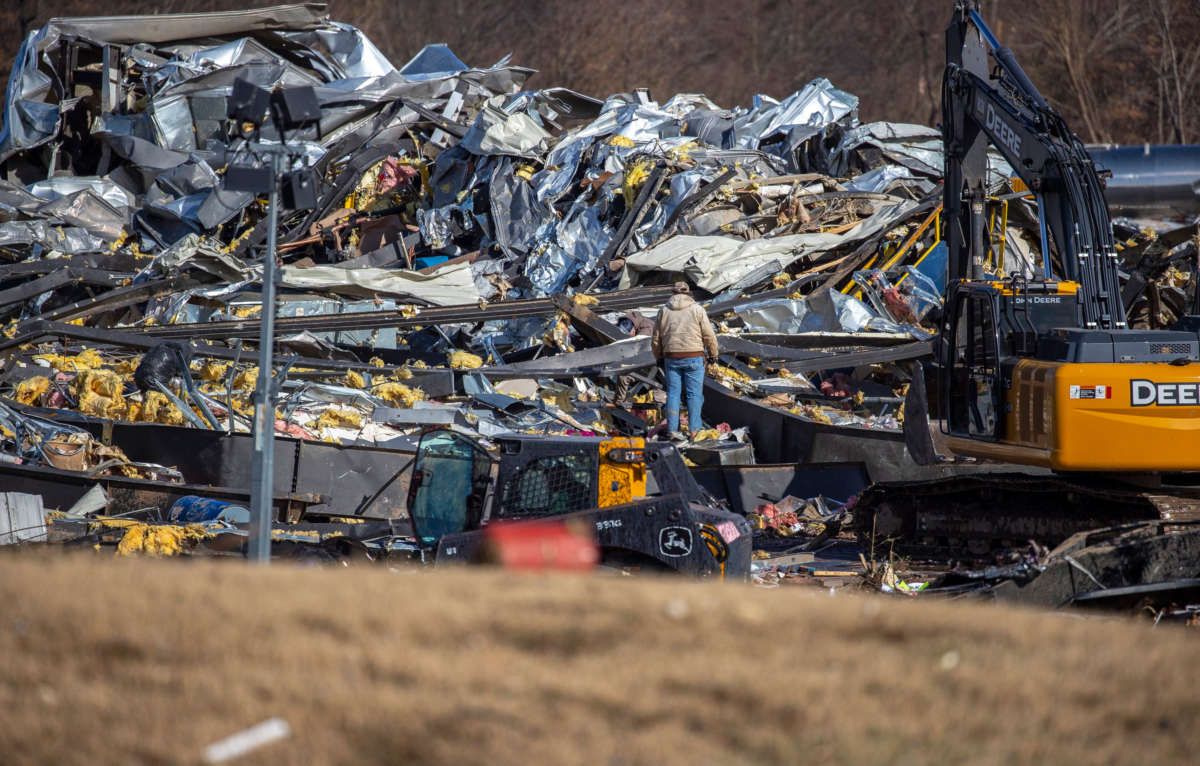Workers in a candle factory in Kentucky and an Amazon warehouse in Illinois were told they were not allowed to leave work as inclement weather that ended up destroying both buildings on Friday night, resulting in multiple deaths, was coming.
At least 15 employees tried to convince managers to let them leave a Mayfield Consumer Products candle factory in Mayfield, Kentucky, hours before a vast storm of tornadoes reached the city, according to reporting from NBC News.
One worker named McKayla Emery, who was injured in the building’s collapse, recalled what happened that night. The first tornado siren sounded off at approximately 5:30 pm. After several minutes, Emery said, after it became clear that a tornado strike wasn’t imminent, workers were still concerned for their safety.
“People had questioned if they could leave or go home,” Emery told NBC. But supervisors warned that anyone leaving could be terminated.
“If you leave, you’re more than likely to be fired. I heard that with my own ears,” Emery added.
Another worker, Elijah Johnson, said the threat of being fired was made directly toward him by management.
“I asked to leave and they told me I’d be fired. Even with the weather like this, you’re still going to fire me?” Johnson said he had asked his supervisor. “Yes,” was their reply.
Managers at the factory were so concerned about attendance that they even took a roll call to find out who had stayed or left, Johnson said. Some workers did leave, in spite of warnings from management.
The storm system did eventually reach the factory, completely decimating Mayfield Consumer Products’s campus. In total, out of 110 employees in the factory that night, eight workers died.
In response, officials from the company have callously described the deaths in a positive light. “We’ve had a miracle situation. Only 8 lost,” Mayfield Consumer Products spokesperson Bob Ferguson said.
Just in: Mayfield Consumer Products spox Bob Ferguson told me that all 110 candle factory workers who were inside when the tornado hit have been accounted for. 102 survived, with the final 2 survivors being located "within the hour."
"We've had a miracle situation. Only 8 lost."
— Ben Tobin (@Ben__Tobin) December 13, 2021
On the same night, at an Amazon warehouse in Illinois, a series of text messages sent by one employee suggests that workers were not allowed to leave that site, either, as the storm approached.
Larry Virden sent messages to his girlfriend Cherie Jones the night the building collapsed, telling her that the company wasn’t allowing him to leave and seek shelter elsewhere. Six individuals, including Virden, died as a result of the building’s collapse.
Virden, who lived about 13 minutes away from the warehouse, sent the messages 16 minutes before the tornado that destroyed the building came, suggesting he was told he couldn’t go home at a moment when he had plenty of time to do so.
“Amazon won’t let me leave until after the storm blows over,” Virden texted Jones. Jones said she didn’t fault the company for his death, but questioned why they couldn’t let him go.
“What if they would have let him leave? He could have made it home,” she said.
The company has since cruelly blamed the deceased individuals for their own deaths, even though, as The Intercept uncovered, Amazon employees say that they receive little-to-no training for emergencies like inclement weather. Workers say that, while the warehouse has done fire drills, they haven’t done tornado drills on their shifts at all.
The workplace standards of both Amazon and Mayfield have been questioned by workers’ rights advocates, who say they’re in desperate need of changing.
“How many workers must die for Amazon to have a policy for extreme weather events?” asked sociologist Nantina Vgontzas.
In a press release from the National Council for Occupational Safety and Health (COSH), the organization said that investigations into both of these tragedies “must include questions about why workers were on the job during extreme weather conditions.”
“What kind of warning systems were in place? What processes do Amazon and Mayfield have in place for emergency preparedness and response?” asked Marcy Goldstein-Gelb, a co-executive director of COSH.
Join us in defending the truth before it’s too late
The future of independent journalism is uncertain, and the consequences of losing it are too grave to ignore. To ensure Truthout remains safe, strong, and free, we need to raise $31,000 in the next 48 hours. Every dollar raised goes directly toward the costs of producing news you can trust.
Please give what you can — because by supporting us with a tax-deductible donation, you’re not just preserving a source of news, you’re helping to safeguard what’s left of our democracy.
